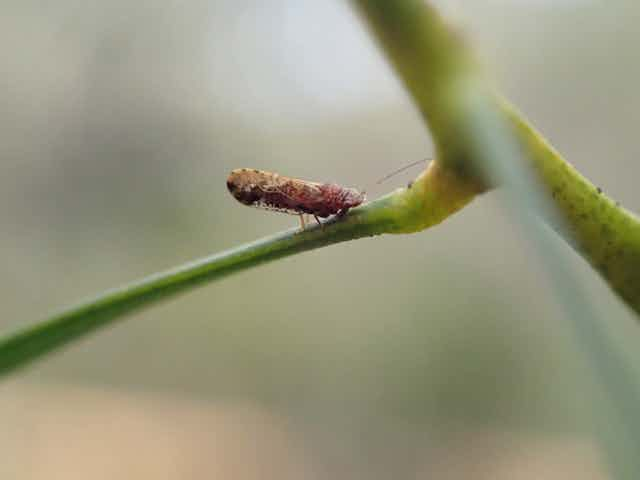Vesk’s Plant-louse (Acizzia veski) was discovered in 2007 within the Stirling Range National Park, a biodiversity hotspot of southwestern Australia. It is not a true “louse” but is a species of Hemiptera, or true bug.
These particular bugs are also called lerp insects (they excrete sugars after feeding on plants).
Vesk’s Plant-louse is an attractive orange with distinctive chocolate brown markings and measures a relatively large 3.5mm. It was named after Melbourne ecologist Peter Vesk for his support of work on the extinction of Australia’s plant-dwelling insects.
All plant-lice are herbivorous, feeding on the sap of their plant hosts, which in the case of Vesk’s Plant-louse is the Western Australian state conservation-listed plant Acacia veronica (a species of wattle). This small tree is endemic to Stirling Range National Park, and, despite there being a number of populations scattered throughout the park, Vesk’s Plant-louse has been found on only one of these populations.
This is surprising, as Vesk’s plant-louse has wings and should be capable of flying to other A. veronica populations. However, these insects are small and may not be able to locate their host plant easily, especially given the diversity of plants in the Stirling Ranges, which is estimated at more than 1,500 species, and the gully habitats that A. veronica is usually found in.
Vesk’s Plant-louse has the dubious honour of being the only species of plant-louse currently listed by the IUCN red list.
There are a whole host of other rare plant-lice that aren’t on the IUCN Red List. These include Glycaspis inusitata, G. wallumaris and G. surculina which all occur on threatened Eucalyptus species in Queensland, the Western Australian Trioza barrettae found on the critically endangered Banksia brownii, and Acizzia mccarthyi, which lives on Acacia veronica alongside Vesk’s Plant-louse.

Status
The exact population size is unknown for both Vesk’s Plant-louse and its host plant A. veronica. However, as the plant-louse only occupies one population of A. veronica, it has been listed as critically endangered by the IUCN red list (July 2013) and vulnerable by the state government (February 2012). Despite having been nominated to the federal government, it has yet to be reviewed.
Threats
Although Vesk’s Plant-louse exists within a national park, there are a number of threats that could extinguish the only known population. As the plant-louse relies on a host plant for its survival, any threat to the plant is also a threat to the insect. This form of extinction is also called coextinction or secondary extinction, and exacerbates the threats faced by the insect.
Vesk’s Plant-louse occurs at the base of a popular mountain, which features a carpark and picnic area in the middle of the host plant population. Therefore any upgrade of the area, including road widening, car park and picnic area maintenance represents a threat to the plant, and consequentially, Vesk’s Plant-louse.
If climate change dries the gully habitat where the host plant is found it could cause the local extinction of the host plant and the global extinction of Vesk’s Plant-louse. Anecdotal evidence suggests that the gully has been drying out over the past 20 years, and recently installed weather stations are attempting to quantify this change.
Finally, while not likely to be a threat to the host plant, a large fire may remove all above-ground plant biomass and reduced access to the food plant could cause the plant-louse’s extinction. It has been speculated that this was most likely the reason for Vesk’s Plant-louse extinction from other populations of A. veronica.

Strategy
No formal management or recovery plan exists for Vesk’s Plant-louse. A current study is trialling the success of translocation of some plant-louse individuals to other A. veronica populations to safeguard the tiny insect from extinction, should anything happen to the one population on which it is currently found.
Conclusion
Threatened species lists usually contain few plant-dwelling insects, such as Vesk’s Plant-louse. It is not because there are fewer rare insects than other animals, but because the majority of plant-dwelling insects are particularly diverse, small, and new species are regularly being uncovered. This is true even within more heavily populated regions such as the southwest of Australia.
To further compound the problem of “megadiversity” there are very few taxonomists and ecologists Australia-wide who study tiny insects like plant-lice, so it is no wonder that such a specialised feeder as Vesk’s Plant-louse has gone unrecorded until now and only recently made threatened species lists.
The Conversation is running a series on Australian endangered species. See it here.

